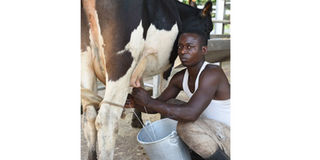Practices that ensure clean milk production

Milkers are advised to always wear a headgear before milking. FILE PHOTO
What you need to know:
The milking parlour should be frequently cleaned to remove slurry. Milking and milk storage containers must be made of food-grade materials, preferably aluminium, writes Fred Muzaale
Milk is regarded as a complete food because it contains all vitamin and minerals such as proteins, fats, carbohydrates that are essential for maintaining good health.
Because of this, it is highly recommended that one takes it regularly, however, in right amounts.
Because milk has all the nutrients and vitamins, it attracts bacteria and germs, which in turn, can be a source of diseases, especially if it is not hygienically handled.
According to Buulu Lugoloobi, the proprietor of Lubus Dairy Farm and information centre in Kayunga District, clean milk production involves measures taken before milking, during the process of milking and post-milking handling of procedures.
“Clean milk production has several stakeholders which include: the health state of the dairy cow, the milker himself, the utensils used in handling milk and the environment in which milking is carried out,” explains Lugoloobi.
The animal
Hussein Kigozi, an animal husbandry officer and lecture at Centenary Community College in Kayunga District, stresses that the dairy cow from which milk is got should be healthy and free from any communicable diseases such as brucellosis and Tuberculosis.
These diseases, he says, can be transmitted from animals to humans through consumption of diseased milk.
He adds that the animal itself should be free from both faecal and urinary contamination because both smells can be absorbed by the milk.
“Milk has capacity to absorb every smell,” Kigozi says.
Additionally, the animal’s udder, teats and flank should be washed before milking starts.
The milker
Before milking, the milker should wash her hands with clean water and a detergent. Besides, he/she must be clean and healthy and free from communicable diseases such as diarrhoea, flue and others. His/her nails must be short as long nails harbour germs that can contaminate the milk.
Kigozi recommends that the person who milks should take medical examination at least three times a year. This would ensure that he/she is medically sound to carry out milking.
On addition to clean clothes, he/she should wear a cap on the head and should not use cosmetics or perfumes when going to milk as the milk would absorb the smell.
The milking environment
Lugoloobi says the milking environment should be clean and free from dung and urine. These attract flies which can fall in the milk and contaminate it.
To avoid this, cows should be milked from a milking parlour and not where they sleep or stay.
After milking, the milk should be sieved to remove foreign particles. It should then be put in clean cans and transported to coolers or places where buyers find it.
The utensils
For clean milk production Lugoloobi says proper utensils should be used during and after milking.
“The utensils used should preferably be made of stainless steel and should have seamless corners as corners harbour bacteria,” he says adding, “Plastic containers are cheap but not easy to wash and sterilise, especially using heat.”
Kigozi stresses the need to wash the utensils that handle milk first with cold water and a detergent before again washing them with hot water. He explains that the hot water kills germs.




